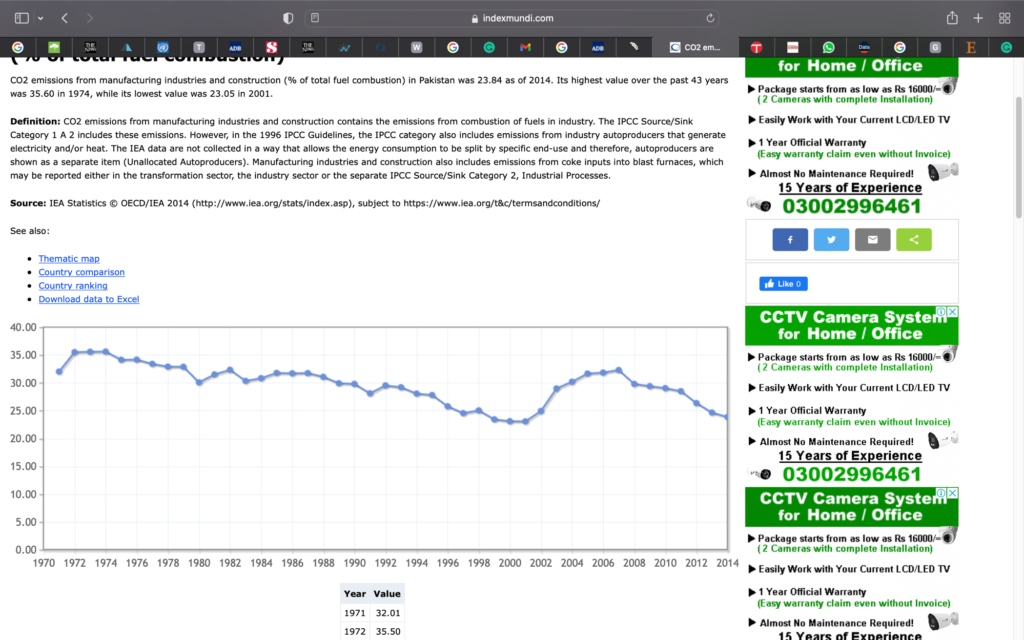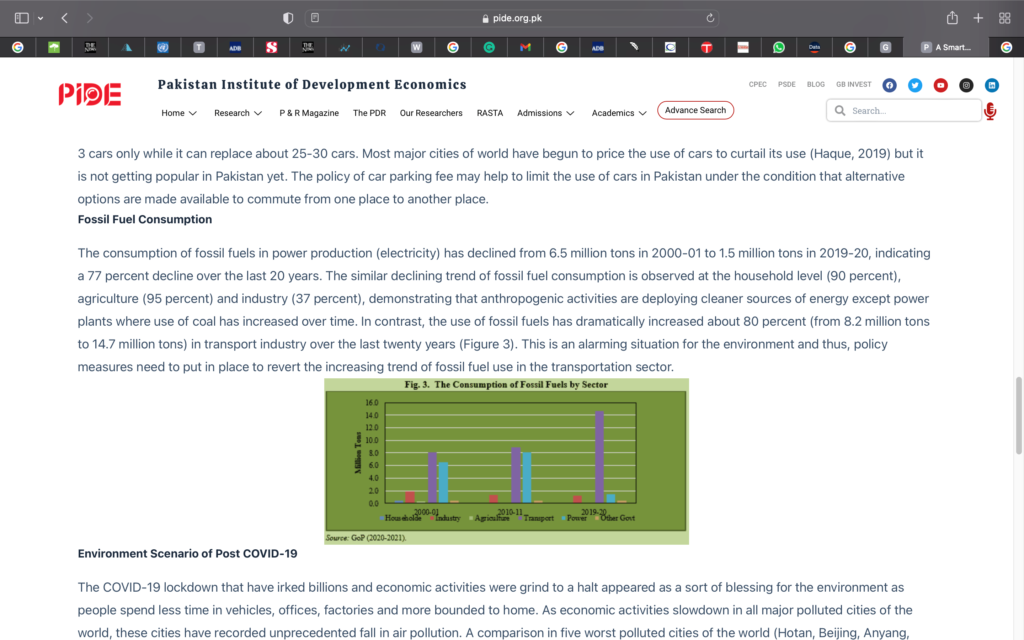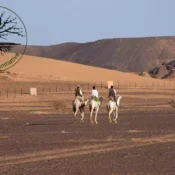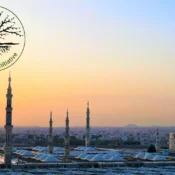
Pakistan Environmental Profile
This environmental profile was produced as part of the Green Waqf Initiative by the
Islamic Chamber of Commerce, Industry and Agriculture (ICCIA). ICCIA believes that
the Islamic concept of Waqf can be used as a social financing mechanism to combat
climate change. Through Waqf, the land is decommodified; therefore, it can be used
only for specific purposes defined by the owner. These purposes can include
reforestation, land revitalization and research centers, among others.
This environmental profile has been developed to assess the ecological situation in
Pakistan and is part of a series that covers all ICCIA member countries. These profiles
are meant to be used as a source to assist in policy dialogue, stakeholder engagement,
and strategic planning and to help educate and raise awareness about the social,
cultural and economic risks associated with climate change. The profiles provide
relevant information on pertinent public and private sector policies and programmes
and the country's adaptation priorities and potentials.
Pakistan Environment Profile Team
Author: Fatima Faisal
Editor: Safia Hussain
Table of Contents
- Introduction
- About ICCIA
- About the environmental profile
- Section 1: Country Overview
- Section 1: Country Overview
- Climate change risks
- Pakistan’s commitment towards climate change
- National Climate Change policy
- Ten Billion Trees Tsunami Program
- REDD and Readiness Preparation Proposal
- Nationally Determined Contributions (NDCs)
- Carbon Markets
- Blue Carbon
- Climate Change Gender Action Plan
- Clifton Urban Forest
- Section 2: Sector-wise climate change causes and effects
- Agriculture
- Manufacturing
- Transportation
- Climate-related migration in Pakistan
- Conclusions & Recommendations
Introduction
About ICCIA
The Islamic Chamber of Commerce, Industry, and Agriculture, an institution affiliated with the
Organization of Islamic Corporation (OIC), aims to strengthen collaboration in the fields of trade,
commerce, information technology, banking, insurance, shipping, joint venture, and many others
within member countries.
ICCIA is the sole representative of the private sector in 57 Islamic member countries and primarily
focuses on creating a knowledge platform for the private sector of the Muslim countries to connect
and learn. It provides visibility to the star performers for future growth and access to new markets.
Additionally, it lays out policy recommendations to enable a private-sector-friendly business
environment in policies, processes, paperwork, and payment system integration, to name a few.
Finally, ICCIA plays an integral role in promoting member country products and increasing access
between home and foreign markets.
About the environmental profile
Several experts claim that insufficient climate control policies have become a 'very serious’ concern
and have been significantly harming a considerable proportion of the world's population.1 Some top
reasons behind climate change include heat-trapping greenhouse gasses, deforestation, use of heavy
machinery, powering buildings, and cutting down on farming livestock.
ICCIA's recent initiative focuses on promoting environmentally friendly and sustainable practices in
member countries to enhance societal impact, minimize waste, and improve living standards.
Pakistan has been one of the most terribly hit countries by climate change challenges. It has long
suffered due to insufficient resources, lack of knowledge, and unwillingness to bring change. ICCIA's
climate change initiative aims toward stabilizing sustainability, promoting ecological practices, and
improving quality of life.
Section 1: Country Overview
General Overview of Pakistan
Pakistan, a Muslim majority state born out of the 1947 sub-continent partition, is the 33rd largest
country in South Asia. It shares borders with India, Afghanistan, China, and Iran. It consists of a
coastline along the Arabian Sea and the Gulf of Oman. Rich in culture and home to several
ethnicities, Pakistan's geography is quite diverse. It has the Thar desert in the east, and the Hindu
Kush and the Pamir Mountains range in the west. Its landscapes range from lofty mountains, the
Himalayas, and the Karakoram, to dissected plateaus and rich alluvial plains of Punjab.
Situated between a 24 latitude and 37 degrees north and a 61 longitude and 75 degrees east, Pakistan
is undoubtedly a land of several splendors. The scenery changes from lagoons, beaches, and
mangroves in the south to fertile plains, deserts, valleys, and glaciers in the north is nothing short of
wondrous.
However, Pakistan encompasses its fair share of challenges like every other country. Despite having
sufficient reserves, glaciers, agricultural landscapes, and others, Pakistan suffers from a severe lack of
resources resulting in excessive food and water shortages and inadequate infrastructure. As of 2022,
Pakistan's overall population was a little over 235 million. This is a 1.9% growth from 2021 and a
striking 16% increase from 2012. Population crises are one of the many challenges Pakistan faces
currently and is a critical reason behind the rising climate change concerns in the country. A recent
report confirms that if the situation remains unaltered, Pakistan will witness a 56% population growth
by 2050, and the population peak will hit by 2080, causing massive havoc.2
Climate change risks
Climate change is becoming a pressing concern nationwide. The United Nations (UN) reports that
rapidly changing climate conditions significantly disrupt millions of lives and harm nature. Moreover,
climate topped the 2022 World Economic Forum (WEF) global risk report, labeling climate as the
riskiest, long-term threat facing humanity.3
Climate change can lead to significant rises in greenhouse gas concentrations, resulting in hotter
temperatures, increased heat-related illnesses, and increased difficulties in working outdoors. Over
the years, Pakistan has become highly vulnerable to climate change. It is mainly because of increased
industrialization and substantial geopolitical consequences. German watch reports that Pakistan ranks among the top 10 countries most severely affected by climate change. According to reports, Pakistan
faces above global average warming rates – around 1.3 °C – 4.9 °C. Moreover, climate change
conditions are resulting in more severe storms and increased droughts– the recent floods in Pakistan
being a prime example of this effect. Pakistan has received 190% more rain than its 30-year average,
causing major floods on an average of 390.7 mm. July of 2022 has been the wettest month in Pakistan
since 1961. These effects are destroying livelihoods, worsening communities, and also harming
animals.4 The 2022 floodings prove that as climate change worsens, the chances of harmful weather
events rise. Over 1290 people lost their lives to these floods, 12,500 injured, and over 33 million
affected. Millions of people lost their families, home, and were entirely dependent on aids and
donations for survival. This was probably the worst flood wave Pakistan had ever witnessed.
The graph below shows the average monthly temperature and precipitation in Pakistan from 1991 to
2020

The graphs below show the June and July rainfall stats.


Pakistan’s commitment towards climate change
National Climate Change policy
There is no secret that Pakistan suffers from a concerning imbalance between its political dominance
and need-of-the-hour action plans, including climate change initiatives. Pakistan first established a
climate change task force in October 2008, representing the first severe efforts by governing bodies to
comprehensively assess climate change's impacts. However, Pakistan's global climate discourse
remained insignificant until 2012. In September 2012, Pakistan introduced its first national climate
change policy. The policy proposed 120 different measures for different areas and identified
vulnerabilities to climate change in agriculture, coastal areas, forestry, water resources, biodiversity,
and many others.
The policy successfully and adequately covers mitigation and adaptation challenges in different
sectors of the economy. Further, the approach aligns with the IPCC AR5 and is informed and
supported by various regulatory documents. However, the policy is facing rising implementation and
inherent institutional challenges. These challenges include long time frames for the impact to unfold,
insufficient cross-sector and multidisciplinary approach, and national and international jurisdictions.
Ten Billion Trees Tsunami Program
The government launched the Billion Tree Tsunami program in 2014, which aimed to plant ten
billion trees by 2023. The strategy is backed by the United Nations Environment Program (UNEP).
It has gained significant international recognition, including acclaim from the World Economic
Forum. It is built on Khyber Pakhtunkhwa's Billion Trees Afforestation Project (BTAP). It has
proven to be a crucial driver for the revival of the forestry sector of Pakistan. As of July – March
FY2021, the project has achieved plantation of 350 million trees and attained more than 814 million
plants through regeneration. The table below depicts the physical and financial progress of the Ten
Billion Trees Tsunamic Program as of FY2020 and FY2021.

The primary objective of the Ten Billion Trees Tsunami Program is to encourage community
engagement and eco-tourism along with the revival of forest and wildlife resources in Pakistan. The
approach aims to enhance the management of 23 protected areas to raise venues for international
standard eco-tourism and create more than 5000 green jobs.5
Furthermore, Pakistan is partnering with the world bank to explore the natural capital account concept
for protected areas. It is believed that the outcome from the natural capital account will help
government strategize better and design evidence-based forestry policies.
REDD and Readiness Preparation Proposal
Reduced Emission from Deforestation and Forest Degradation (REDD) is a concept implemented and
adopted by countries under United Nations Framework Convention on Climate Change (UNFCCC).
REDD and R+PP have been widely implemented in Pakistan since 2015. Through world bank’s
Forest Carbon Partnership Facility (FCPF) conducted a competitive process to award the funding to
Pakistan. The four components needed to finish the REDD and readiness phase necessitated the
documentation preparation by both international and domestic advisors.
Nationally Determined Contributions (NDCs)
According to UNDP, Pakistan has committed to set a conditional target of an overall 50% reduction
of its total projected emissions by 2030 by lowering the country’s resources by 15% and subjecting
35% to international finance funding. To achieve the target, Pakistan aims to migrate to 60%
renewable energy and 30% electric vehicles, ban coal imports, and expand nature-based solutions by
2030.6 The UNDP is helping Pakistan keep its climate promise by enhancing adaptation and
resilience, inclusion, climate finance, energy, Covid-19 recovery, forest, land, nature, and
transparency.
For improved commitments, Pakistan aims to include new gasses in GHG inventory and new sectors,
including health co-benefits, electric vehicles, and blue carbon. The NDCs' primary objective leans
toward institutionalizing the government approach to revising and reporting on climate action.
During President Joe Biden's Leader's summit, Pakistan claimed to be consciously working towards
creating forward-looking policies to eliminate climate change challenges and remain fully committed
to the role.
Carbon Markets
Confirming the Paris Agreement, Pakistan intends to establish cohesive and powerful carbon markets
to generate financial resources and green jobs. Carbon markets can significantly boost Pakistan’s
sustainability recovery from economic regression. Ministry of Climate Change (MoCC ) recently conducted a study on the Introduction of Carbon Pricing Instruments with support of the United
Nations Framework Convention on Climate Change (UNFCCC). As a response, the National
Committee on the Establishment of Carbon Market (NCEC) was entrenched.
However, the plan is only fit for the books currently. No real action has been taken to establish
carbon markets in Pakistan
Blue Carbon
To determine how and where to take action to safeguard and advance blue carbon potential, the
Ministry of Climate Change performed a Blue Carbon Rapid Assessment for Pakistan with the
assistance of the World Bank. The findings directed that approximately 21 million tonnes of organic
carbon (Corg) or 76.4 million tonnes of CO2 are stored in mangrove forests and mapping tidal
wetlands.
Sindh Government’s recent Indus Delta Mangroves REDD + project, currently being conducted on
350,000 ha, is projected to eliminate 25 million CO2 by 2030 and 150 million
by 2075.7

Climate Change Gender Action Plan
International Union for Conservation of Nature (IUCN) and the ministry of climate change, the
government of Pakistan have formulated an initiative to incorporate gender equality and women’s
empowerment in its latest climate change action plan. With the financial support of Green Climate
Fund, Pakistani government has launched its first-ever climate change Gender Action Plan (ccGAP).
This plan will ensure that women have sufficient rights to effect climate change decisions and are
given equal representation.8
However, the true effects of the ccGAP are yet to be seen. The plan is still within its implementation
phase and its outcome can only be perceived once the action is executed.
Clifton Urban Forest
While the Billion Tree Tsunami program is backed by significant funding and official ministries,
several small-scale programs are being carried out nationwide to combat climate change concerns.
One such initiative is the Clifton urban forest program backed up by the Sindh government. Their
goal is to plant over 50,000 trees that will help lowering the ambient temperature and hold thousands
of gallons of run-off water.9 Till now, the Clifton Urban Forest initiative has been successful in
planting 40,000 tree saplings and 45 species of trees.
Section 2: Sector-wise climate change causes and effects
Agriculture
Agriculture is Pakistan’s dominating sector and significantly contributes to food security in the
country. Nearly 60% of the population is either directly or indirectly reliant on red-fed agriculture that
depends on weather predictions.10 Rapid climate change is increasingly affecting Pakistan’s
agricultural sector, deteriorating crop conditions and worsening farm livelihoods. The incessant
escalation in the earth’s temperature accompanied by changing precipitation patterns is severely
affected agricultural production of crops including wheat, rice, cotton, sugarcane, and maze.11
Moreover, the shift in the monsoon season is exacerbating farming and agribusiness infrastructure.
These effects are leading to rising food insecurity and malnutrition in the farming community.
A recent study claims that average temperature will rise by 5-6 oC by the end of the century. This will
affect 50% wheat production in Asia with Pakistan bearing the greatest loss due to its geographical
position.12
However, it is crucial to note that the agriculture sector is itself a major contributor towards climate
change issues. On average, agriculture generates 19-29% of total greenhouse gas emissions including
significant release of methane and nitrous oxide.13 Without action, the number could rise
exponentially and deteriorate the situation further.
Manufacturing & Construction
Similar to Agriculture, construction and manufacturing have a two-way dynamic with climate
change. On the one hand, construction and manufacturing contribute significantly to climate change.
On the other hand, climate change affects the industry in several ways.
According to reports, the building industry is a major contributor to atmospheric carbon dioxide
emissions (CO2). To reduce CO2 emissions, the building sector is facing several problems and
difficulties.14
The topography and natural environment that are already present are negatively impacted by
construction as concrete and steel structures are built there. Land erosion, desertification and
dereliction are a few inevitable fallouts of large-scale construction pursuit. Further, the depletion of
the natural climate and destroying habitats for wildlife, flora, and fauna create imbalances in the
ecological order.
Natural resources must necessarily be depleted to supply basic raw materials like cement, bricks,
gravel, iron, steel, and other metals, as well as wood. Energy-intensive fuels like coal, gas, and oil are
used in producing and processing these commodities, which releases greenhouse gases and acidifying
gases into the environment.
The graph below shows the CO2 emissions from manufacturing industries and construction in
Pakistan.

Moreover, there are between 18,000–20,000 traditional brick kilns that mostly burn coal and release
deadly black carbon emissions into the atmosphere. Most are found near populated regions, which
considerably worsen air pollution. The brick kiln sector employs more than one million people and
generates about 80 billion bricks annually, despite the fact that there is a need for more than 110
billion bricks. Even though it is regarded as an informal sector, the brick industry is responsible for
nearly 1.5% of the nation’s GDP.15
Energy conservation and efficiency in the building and construction sector have been listed as one of
the key areas in which Pakistan may fulfil its SDG obligations in the Climate Change Act of Pakistan.
One of the main areas where the government has worked with the major industry players and
launched a program to convert the current traditional brick kilns is the brick kiln improvement sector.
The outdated fossil fuel-powered kilns are intended to be replaced with environmentally responsible
Zig-Zag technology, which can lower carbon emissions that cause smog by 60% and save energy by
30%.16 The SDGs—No Poverty, Good Health and Well-Being, Decent Work and Economic Growth,
and Climate Action—are also being met by Pakistan thanks to this program.
On the other side, climate change can make the construction industry vulnerable. If the issue is not
catered to, risks of collapse, declining health, and loss of value will increase. All of this could lead to
a deteriorating indoor climate and reduced building lifetime.
Transportation
The transport industry is one of the major contributors to climate change in Pakistan.17 The
Transportation industry in Pakistan is known to generate the highest level of fossil fuels causing
excessive pollution, smog, and increasing risks of oil rig explosions. The graph below indicates the
consumption of fossil fuels by the transportation industry from 2000 – 2020.

Pakistan's total primary energy consumption through transport doubled between 1990 and 2019. In
contrast, the worldwide energy consumption by the transport sector climbed from 25 to 30 per cent.
In Pakistan, the residential proportion is arguably the most significant (48%), followed by industrial
(25%) and finally transportation (18.4 pc). With industry data showing high combustion-engine
vehicle sales for the last two years — driven by new vehicle manufacturers' entry into Pakistan and
more choices for the increasingly affluent urban consumers — on the one hand, cities choked with
smog for several months at a time on the other, the impact of current sectoral dynamics is becoming
ever more evident.
The first policy to establish challenging zero-emission car targets—also known as an electric vehicle
or EV targets—was the Pakistan Electric Vehicle Policy, published in 2019. This meant focusing on
deploying zero-carbon-emission vehicles, including two- and three-wheelers, cars, buses, and trucks.
The policy established adoption goals for these, in addition to incentives for manufacturers and
consumers. For instance, the ambitious target for new car sales was established at 30% by 2030 and
90% by 2040.18
As mentioned previously, the rapid urbanization in major cities of Pakistan has led to the construction
of several jammed buildings and other estates, leading to a massive rise in temperatures in the
country. Given that more than 60% of the Pakistani population travels on bikes, this temperature rise
could significantly deteriorate the people’s health. Moreover, the release of greenhouse and other
toxic gasses could be highly hazardous to people commuting on bikes or non-airconditioned vehicles.
A smart shift from private to public transport can significantly reduce the effect of climate change on
the transportation industry and vice versa. The Pakistani government is currently focusing on
diverting public’s interest towards using public transportation by introducing cheaper, eco-friendly
alternatives such as green line bus service and people’s bus service.19
Climate-related migration in Pakistan
At this point, it is well-established that Pakistan is suffering from a severe climate crisis and despite
of several established and proposed policies, the situation does not seem to be improving. The 2022
flooding is a highly relevant example of Pakistan’s deteriorating climate change condition, causing
chaos and imbalances in the country.
Another highly relevant effect of the ongoing climate change condition is the climate induced
migration in the nation. There have been several reports and surveys conducted over the past few
years which shows a huge number of people are willing to migrate to less-effected areas of Pakistan.
This is somewhat synonymous with the rural to urban migration since climate change primarily
effects the ruling class residing in underdeveloped, rural areas of the country.
Floods that inundated one-fifth of the nation in 2010 caused more than two million people to be
displaced, which led to a large-scale migration from rural Pakistan to urban areas. According to
Muhammad Saleem, spokesman for the Ministry of Climate Change, of that number, about 70% did
not return to their hometowns and instead permanently relocated to large cities in order to make a
living.20 This was due to the loss of their homes and farmlands. In the past ten years, he claimed,
seasonal, long-term, and permanent migrations had occurred in southern, southwestern, and
northeastern Pakistan, primarily as a result of drought and flooding.
Conclusion & Recommendations
Climate change is a significant concern affecting third-world countries like Pakistan to a great extent.
This profile portrays some of the major issues facing Pakistan regarding climate change and urges
immediate action to prevent further economic deterioration.
Better economic and sectorial policies coupled with less political instability and enhanced
governmental strategies could help Pakistan tackle climate change issues and improve its current
situation. Since Pakistan is an agriculture-based economy, it would be best to start by laying out
efficient agricultural vs climate change policies. A climate-smart agriculture approach could increase
sustainable productivity, reduce agriculture's greenhouse gas emissions, and strengthen farmers'
resilience.
However, other policies, including improved public transport, proper waste disposal, and stricter
regulations on construction, must be implemented simultaneously to witness a more diverse effect.
Pakistani government could help by undertaking reforestation and afforestation programs, building
dams in water-insufficient areas like Thar, and making climate change a priority in the development
and political agenda.
More than anything, increased activism about the subject is required currently. More talks about
climate change and its effects equal more people getting informed and educated on the matter.



